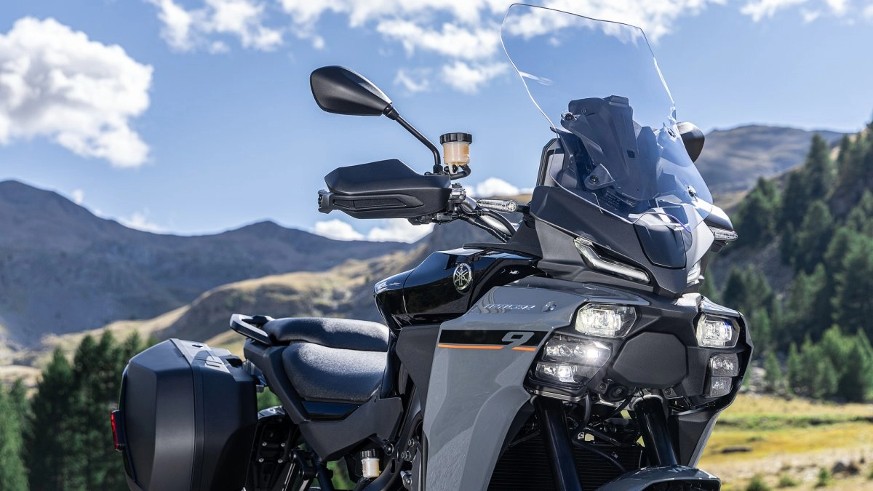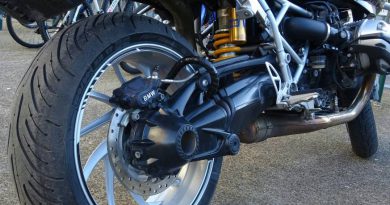
Light Where You Need It: Aiming Headlights
A properly aimed headlight is essential for ensuring clear visibility on the road and helping other drivers see you. If your headlight is aimed too high, it can blind oncoming drivers, creating a dangerous situation. If it’s aimed too low, you might not see far enough ahead to ride safely. This is why regularly checking and adjusting your headlight aim is so important. A well-aimed headlight is one that gets noticed without annoying oncoming drivers.
Whether you’re riding solo, with a passenger, or carrying luggage, understanding how to adjust your headlight aim for each situation can make your rides safer and more enjoyable.
How Additional Weight Affects Headlight Aim
Carrying extra weight, like a passenger or luggage, changes the balance of your motorcycle. When the rear end is weighed down, the front end tilts upward, causing the headlight to aim higher than usual. This not only reduces your ability to see the road but can also blind other drivers.
One way to help compensate for this shift is by adjusting your motorcycle’s suspension settings. Increasing the preload on your rear suspension can reduce the sag caused by additional weight, helping keep your bike level and maintaining proper headlight aim. For details on how to adjust preload to handle luggage and passengers, check out the AmericanSportTouring.com guide How to Adjust Preload for Sport Touring.
Step-by-Step: How to Adjust Your Motorcycle Headlight Aim
Follow these steps to check and adjust your headlight’s aim:
1. Find a Suitable Space
Look for a flat surface with a vertical wall where you can measure the headlight beam. Dim or dark settings, such as a garage or a quiet parking lot at night, work best for this.
2. Measure the Distance
Position your motorcycle about 25 feet (7.6 meters) from the wall. Ensure the bike is upright and level, with both tires properly inflated and your suspension set for your usual riding conditions.
3. Mark the Wall
Measure the height of your headlight from the ground to its center. Transfer this measurement to the wall by marking it with tape or chalk at the same height.
4. Turn on the Headlight
Switch on your low beam and observe where the light hits the wall. The brightest part of the beam should be just below the line you marked earlier.

5. Adjust as Needed
If the beam is too high or too low, adjust your headlight by using the adjustment screws or dials located on or near the headlight assembly.
- Vertical adjustments: Adjust the screws until the top of the beam is just below the line on the wall.
- Horizontal adjustments (if available): Ensure the center of the beam is directly in front of the headlight and not skewed to one side.
Feel free to check that your highbeam is working as well, but separate adjustment is not necessary.
6. Check for Changes in Load
After you’ve set the aim for solo riding, check it again when you add a passenger or luggage. If the headlight is still aimed too high due to the extra weight, you may need to adjust the aim or consider increasing the preload on your suspension.
Re-check Headlight Aim Regularly
Headlight aim can shift over time due to vibrations, suspension adjustments, or changes in tire pressure. It’s a good idea to check your headlight aim every few months or after significant rides, especially if you’ve made any changes to your bike’s setup.
Regular checks are particularly important when carrying extra weight. While adjusting the preload can help keep your bike level, you should still verify that the headlight beam is aimed correctly before long trips or nighttime rides.
Let There Be Light
A properly aimed headlight is critical for both your safety and the safety of others on the road. Regularly checking and adjusting your headlight, especially when adding weight from passengers or luggage, ensures that you see the road ahead clearly and are visible to other drivers. By paying attention to your suspension settings and keeping your headlight in check, you’ll be ready for any road, day or night.
And don’t forget to check out How to Adjust Preload for Sport Touring for tips on adjusting your motorcycle’s preload to manage extra weight and maintain proper headlight alignment.
[placeholder text]
Your response is used by American Sport Touring only, we do not store or sell your information.
Please read our Privacy Policy.

by John DeVitis, Editor and Publisher
John DeVitis, Editor & Publisher of American Sport Touring, has spent years riding and writing with a focus on long-distance, performance-oriented motorcycling. His time on the road has revealed little-known routes across the United States and Canada, along with practical insights into the bikes, gear, and techniques that matter to sport touring riders. He draws on this experience, together with a background in digital publishing, to guide the editorial principles and clear vision behind American Sport Touring, delivering content riders can trust.




